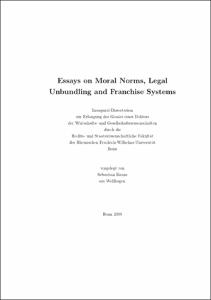Online-Ausgabe in bonndoc: https://nbn-resolving.org/urn:nbn:de:hbz:5-16103
urn: https://nbn-resolving.org/urn:nbn:de:hbz:5-16103,
author = {{Sebastian Kranz}},
title = {Essays on Moral Norms, Legal Unbundling and Franchise Systems},
school = {Rheinische Friedrich-Wilhelms-Universität Bonn},
year = 2008,
note = {
This dissertation studies three, rather unrelated, topics, which are investigated in 4 independent chapters.
Chapter 1 analyses a model of incomplete information with selfish rational types and types who comply with social or moral norms by intrinsic motivation. It explores ’complier optimal norms’, which maximize expected average utility of all compliant types given that the norms are commonly known. They are compared with rule-utilitarian norms, which maximize the sum of all players’ utility. Predictions under complier optimal norms match experimental evidence better and can explain a wide range of stylized facts, like conditional cooperation, costly punishment, the role of intentions, or concerns for social efficiency. It is shown that complier optimal norms arise from a model of voting-by-feet and can also be justified on moral grounds.
Chapter 2 studies an industry in which an upstream monopolist supplies an essential input at a regulated price to several downstream firms. Different forms of ownership of the upstream firm by the downstream incumbent are analysed. In particular, there is a focus on a hybrid form between ownership separation and vertical integration called legal unbundling. In the model, legal unbundling means that a downstream firm owns the upstream firm, but this upstream firm is legally independent and maximizes its own upstream profits. The model allows for non-tariff discrimination by the upstream firm and show that under quite general conditions legal unbundling yields (weakly) higher quantities in the downstream market than vertical separation and integration. Therefore, typically, consumer surplus will be largest under legal unbundling. Outcomes under legal unbundling are still advantageous when allowing for discriminatory capacity investments, investments into marginal cost reduction and investments into network reliability. If access prices are unregulated, however, legal unbundling may be quite undesirable.
Chapter 3 extends the analysis of Chapter 2 by studying imperfect legal unbundling and partial ownership. Reducing imperfections in legal unbundling (keeping ownership fixed) generally increases total output. Increasing the incumbent's ownership share increases total output if imperfections are sufficiently small, otherwise the effects are ambiguous. Surprisingly, higher ownership shares of the downstream incumbent may sometimes lead to lower degrees of imperfections. The analysis suggests that consumers may benefit most from legal unbundling with strong regulation and parts of ownership given to a minority outside shareholder.
Chapter 4 is motivated by the fact that many successful franchise chains directly own a positive fraction of stores, a structure referred to as plural form. It is proposed that this ownership structure is chosen as a commitment not to expropriate franchisees. The theoretical model is based on an empirical analysis of contract and interview data from the US fast-food sector and well known stylized facts: First, franchisees typically have strong contractual obligations to implement activities selected by the chain. Second, franchisees pay a revenue-based royalty to the chain. Therefore, the chain has incentives to select inefficient activities that yield high revenues but are too costly. If uniform standards require that activities must be the same in company-owned and franchise stores, a substantial fraction of company-owned stores works as a commitment device to select more efficient activities. The theoretical analysis further predicts that a strong contractual commitment to uniform standards is preferable if the fraction of company-owned stores is sufficiently high. This prediction is supported by our data.
url = {https://hdl.handle.net/20.500.11811/3327}
}






